| View previous topic :: View next topic |
| Author |
Message |
Pierre Joubert
Joined: 09 Mar 2012
Posts: 1605
Location: Western Cape



|
 Posted: Jun 15, 2015 10:51 Post subject: Removing stubborn minerals from quartz Posted: Jun 15, 2015 10:51 Post subject: Removing stubborn minerals from quartz |
|
|
I have searched the database on how to clean 'difficult' clay from quartz and only found an article on removing the same from Tourmaline. I have found that some hard clays can only be removed with a weak solution (5%) of Hydrofluoric acid. I have also found that some clays can only be removed by alternating between Hydrochloric and Oxalic acid. In the latter's case, I am quite sure that there was a mix of calcite and clay. I have/had many fine specimens from the Northern and Western Cape (RSA) and Namibia, with very stubborn clay on them, that would have looked much better without the pesky clay. I think that if one knew exactly what the clay (or sediment) consisted of, then one could target the cleaning process better. I suspect that the purer the feldspar content, the more difficult the cleaning. My only success so far has been with a small amount of a 5% solution of HF acid (I have very little interest in attempting to use a stronger HF solution). Will anyone with extensive cleaning experience please share your wisdom?
| Mineral: | Quartz and feldspar? |
| Locality: | | Goboboseb Mountains, Brandberg area, Erongo Region, Namibia |  |
|
| Dimensions: | 26 x 14 x 12 mm |
| Description: |
|
| Viewed: |
45925 Time(s) |
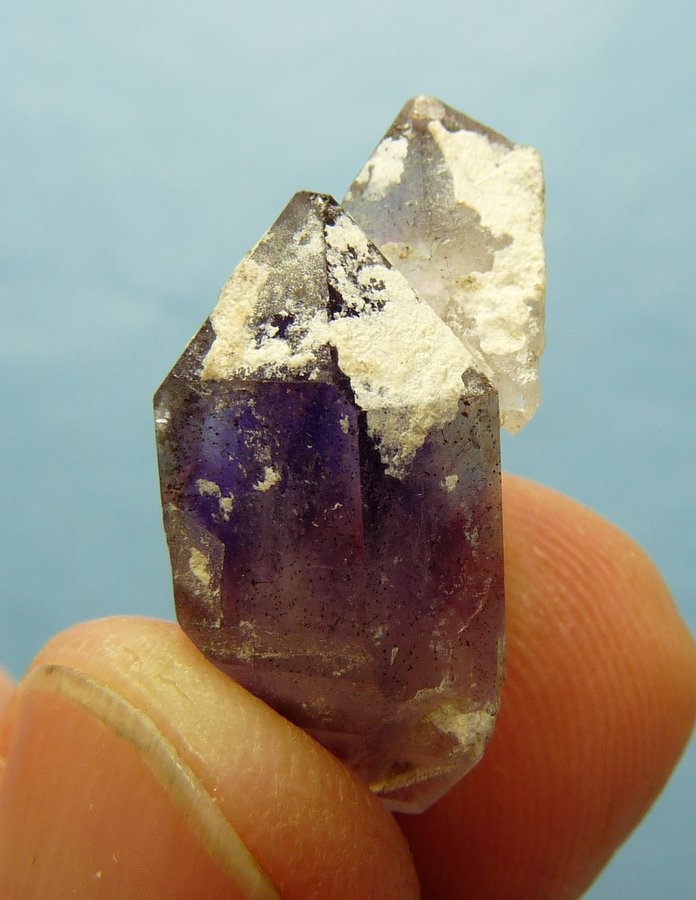
|
_________________
Pierre Joubert
'The tree of silence bears the fruit of peace. ' |
|
| Back to top |
|
 |
GneissWare

Joined: 07 Mar 2008
Posts: 1287
Location: California



|
 Posted: Jun 15, 2015 11:02 Post subject: Re: Removing stubborn minerals from quartz Posted: Jun 15, 2015 11:02 Post subject: Re: Removing stubborn minerals from quartz |
|
|
Probably the best way is by using a micro-abrasion unit with glass beads. Even weak HF will cause some etching of the quartz. Some people have had success with HF that has been used for cleaning lots of quartz and fluorite -- somehow it ends up buffered so that it doesn't attack crystalline quartz, but will remove drusy quartz coating and clays.
| Description: |
|
| Viewed: |
45942 Time(s) |
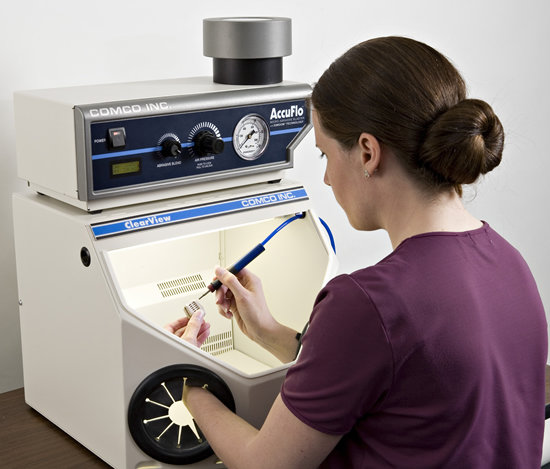
|
|
|
| Back to top |
|
 |
lluis
Joined: 17 Nov 2006
Posts: 719


|
 Posted: Jun 15, 2015 11:06 Post subject: Re: Removing stubborn minerals from quartz Posted: Jun 15, 2015 11:06 Post subject: Re: Removing stubborn minerals from quartz |
|
|
Goiemore, Pierre
I have used sometimes fluorhidric acid, but I dislike it; and it is too dangerous, besides...
But maybe what I learned from Lapis will be helpful. Place the piece in a 10% solution of sodium hydroxide and heat to 60ºC for one or two hours. Let cool and brush; this could help you....
It worked for me with some wulfenites on quartz from Switzerland: clay brushed away, leaving the quartz very shiny and the wulfenites undamaged.....
Hope this helps.
LLuís
P.D.: sodium hydroxide is very corrosive.... Goggles and gloves should be used,,,,
|
|
| Back to top |
|
 |
chris
Site Admin

Joined: 12 Jul 2007
Posts: 538
Location: Grenoble



|
 Posted: Jun 15, 2015 11:42 Post subject: Re: Removing stubborn minerals from quartz Posted: Jun 15, 2015 11:42 Post subject: Re: Removing stubborn minerals from quartz |
|
|
Hello Pierre,
A cousin of mine also use an ultrasonic cleaner with water + detergent to remove clays from minerals. Maybe you can rent one and try it on a trial specimen. From memory, quartz doesn't like HF acid, so be careful with it. Moreover HF acid is very dangerous and should be handled with appropriate protective gear such as that used in laboratories. My advice is don't use it and go with the advice of Lluis & Bob or mine.
Cheers
Christophe
|
|
| Back to top |
|
 |
Joseph DOliveira

Joined: 29 Jan 2012
Posts: 311
Location: Hanmer, Ontario



|
 Posted: Jun 15, 2015 20:21 Post subject: Re: Removing stubborn minerals from quartz Posted: Jun 15, 2015 20:21 Post subject: Re: Removing stubborn minerals from quartz |
|
|
Hi Pierre,
A cheaper alternative to the micro abrader is a simple automotive bench sand blaster with glass beads. When I first used one, I went to my local auto repair shop and asked if I could try cleaning a specimen in their sand blaster. They were more than open to helping me out and it worked. One case of beer later and I had my entire batch of pyrite pseudo marcasite specimens cleaned of hard clay and other tough oxides. I later purchased a unit from a local store on sale for just over $125 and it has become a go to piece for cleaning harder specimens.
I also use an ultra sonic cleaner as well but it generally takes significantly longer and the tough clay still has to be abraded off. The unit was purchased on line and works fine but it is not as successful on tougher clay. I have also used the water blasting guns with success, I salvaged a lot of nice green apophyllite that was completely covered in a dirty druzy quartz, I aimed the blaster at the open edges and the quartz was blasted off. It actually surprised me at how easy it was, as I had tried using dental picks and was not nearly as successful.
Good luck with your project, please let us know how it works out.
Cheers,
Joseph
_________________
Joseph D'Oliveira
Hanmer, Ontario
Canada |
|
| Back to top |
|
 |
Pierre Joubert
Joined: 09 Mar 2012
Posts: 1605
Location: Western Cape



|
 Posted: Jun 16, 2015 05:21 Post subject: Re: Removing stubborn minerals from quartz Posted: Jun 16, 2015 05:21 Post subject: Re: Removing stubborn minerals from quartz |
|
|
I appreciate all the input. I must say, this is a real pain in the 'whatchamacallit'; and I am referring to the 'battle of clay' (and other resistant substances). I studied the faces of some of the specimens cleaned with a 5% HF solution, and they do not appear to be etched. Perhaps because I only had them in for about 2 days. Nevertheless, if I can find a substitute for HF acid, I will be glad. One of my friends successfully removed feldspar from Schorl by the process of blasting with glass beads. Most of the crystals I clean are fairly small (15 - 50 mm), so I would prefer a chemical solution. I will attempt Lluis advice first and see if it works; then look at purchasing a micro abrader with beads.
I believe the main culprit is feldspar that somehow cements itself onto quartz. It would be nice to find a chemical that weakens(or dissolves) feldspar without affecting quartz.
| Mineral: | Quartz with clay |
| Locality: | | Cape Lime Company's Dolomite Quarry, Vredendal, West Coast District, Western Cape Province, South Africa |  |
|
| Dimensions: | 32 x 15 x 15 mm |
| Description: |
|
| Viewed: |
45609 Time(s) |
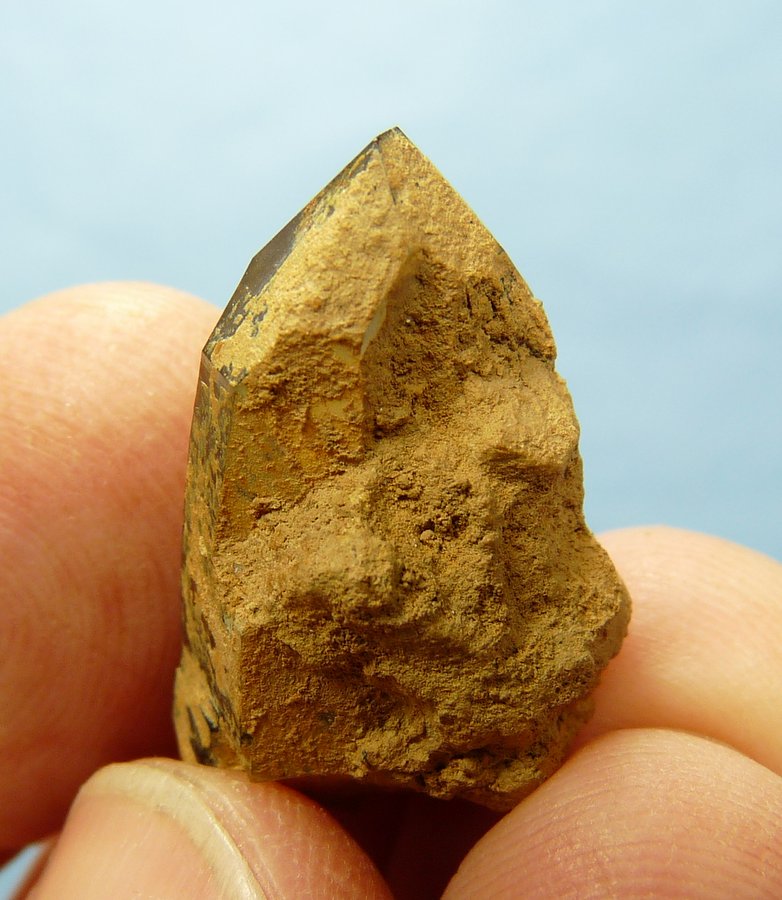
|
| Mineral: | Quartz with clay |
| Locality: | | Cape Lime Company's Dolomite Quarry, Vredendal, West Coast District, Western Cape Province, South Africa |  |
|
| Dimensions: | 32 x 15 x 15 mm |
| Description: |
|
| Viewed: |
45645 Time(s) |
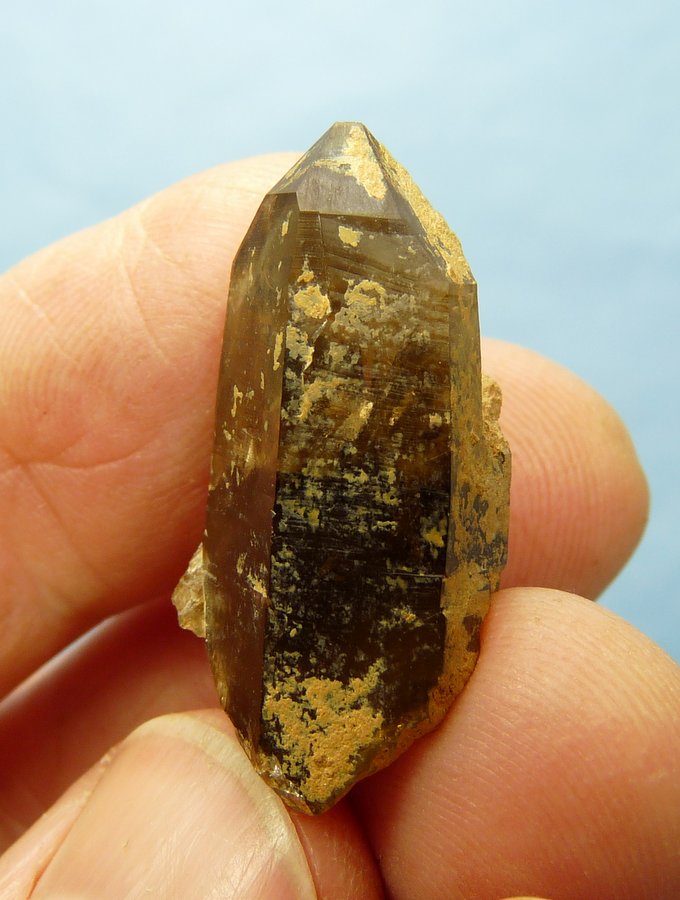
|
_________________
Pierre Joubert
'The tree of silence bears the fruit of peace. ' |
|
| Back to top |
|
 |
Pierre Joubert
Joined: 09 Mar 2012
Posts: 1605
Location: Western Cape



|
 Posted: Jun 16, 2015 05:51 Post subject: Re: Removing stubborn minerals from quartz Posted: Jun 16, 2015 05:51 Post subject: Re: Removing stubborn minerals from quartz |
|
|
I just had a look at a video on how to make sodium hydroxide. It appears that the secret lies in heating up the solution. If it boils it can dissolve glass. I purchased a bottle of this chemical and used it without result. It appears that the answer lies in heating it.
https://www.youtube.com/watch?v=nue1ZGSleEo
(Link normalized by FMF)
_________________
Pierre Joubert
'The tree of silence bears the fruit of peace. ' |
|
| Back to top |
|
 |
Pete Richards
Site Admin
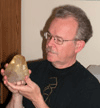
Joined: 29 Dec 2008
Posts: 846
Location: Northeast Ohio



|
 Posted: Jun 16, 2015 08:59 Post subject: Re: Removing stubborn minerals from quartz Posted: Jun 16, 2015 08:59 Post subject: Re: Removing stubborn minerals from quartz |
|
|
| Pierre Joubert wrote: | | I believe the main culprit is feldspar that somehow cements itself onto quartz. It would be nice to find a chemical that weakens(or dissolves) feldspar without affecting quartz. |
I would encourage you to try to get an analysis to check whether this is really feldspar. It certainly does not look like feldspar to me - though "analysis by eye" is about the weakest form of evidence there is! If the usual stuff is something other than feldspar, then you're wasting your time looking for a way to remove feldspar.
_________________
Collecting and studying crystals with interesting habits, twinning, and epitaxy |
|
| Back to top |
|
 |
GneissWare

Joined: 07 Mar 2008
Posts: 1287
Location: California



|
 Posted: Jun 16, 2015 09:12 Post subject: Re: Removing stubborn minerals from quartz Posted: Jun 16, 2015 09:12 Post subject: Re: Removing stubborn minerals from quartz |
|
|
| Pierre Joubert wrote: | I just had a look at a video on how to make sodium hydroxide. It appears that the secret lies in heating up the solution. If it boils it can dissolve glass.
(Link normalized by FMF) |
Be extremely careful with hot NaOH. Not as nasty as HF, but it can certainly cause life-threatening injuries.
|
|
| Back to top |
|
 |
Pierre Joubert
Joined: 09 Mar 2012
Posts: 1605
Location: Western Cape



|
 Posted: Jun 16, 2015 12:49 Post subject: Re: Removing stubborn minerals from quartz Posted: Jun 16, 2015 12:49 Post subject: Re: Removing stubborn minerals from quartz |
|
|
Hi Pete and Bob, I value your advice. The smoky quartz has a stubborn clay. I believe clay is mostly weathered feldspar. Pete, so if I understand you correctly then feldspar must be seen as a 'permanent fixture'. This is not good news to me, but I will accept it. I will have to get an analysis from a university on the stubborn clay and see what the best way is to tackle the cleaning process. I include yet another 2 pictures of quartz and (I think) feldspar.
Bob, I will appreciate advice on handling NaOH. I know that it has to be used outside because of poisonous gasses.
| Mineral: | Quartz with feldspar |
| Locality: | | Steinkopf, Namakwa District (Namaqualand), Northern Cape Province, South Africa |  |
|
| Dimensions: | 41 x 30 x 21 mm |
| Description: |
|
| Viewed: |
45584 Time(s) |
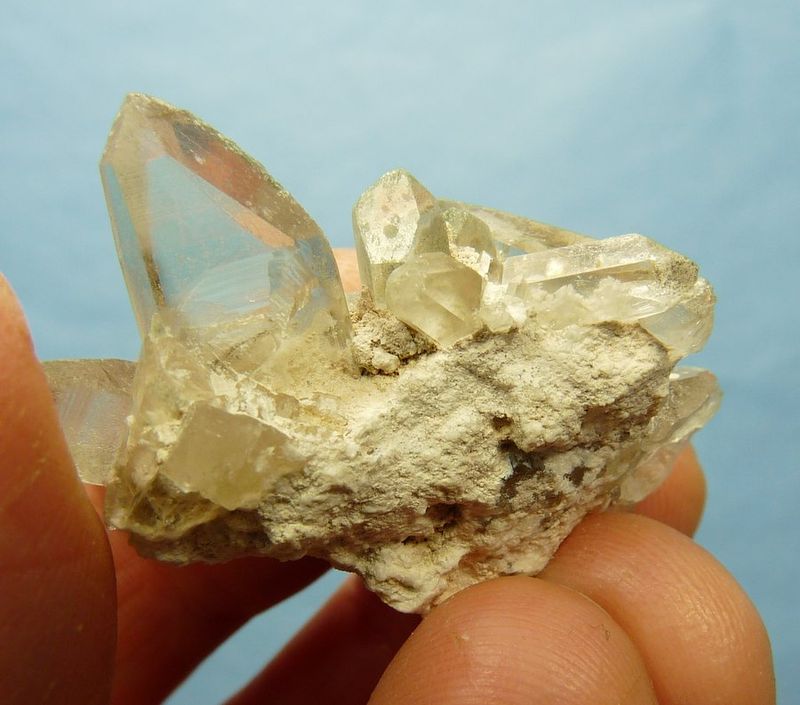
|
| Mineral: | Quartz with feldspar |
| Locality: | | Orange river pegmatites, Kakamas, ZF Mgcawu District, Northern Cape Province, South Africa |  |
|
| Dimensions: | 24 x 22 x 20 mm |
| Description: |
|
| Viewed: |
45603 Time(s) |
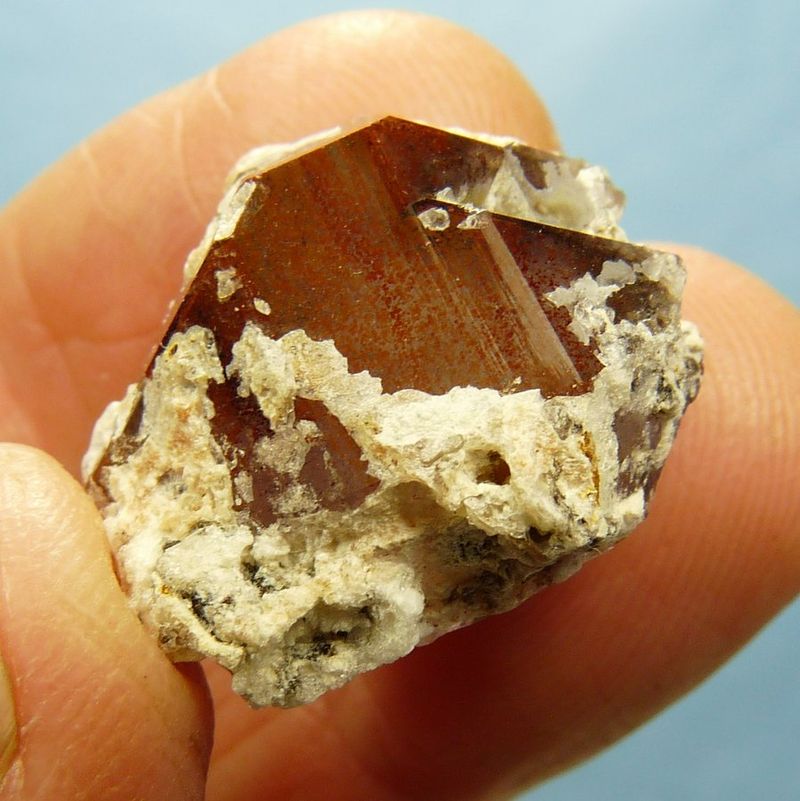
|
_________________
Pierre Joubert
'The tree of silence bears the fruit of peace. ' |
|
| Back to top |
|
 |
Mike Wood

Joined: 16 Dec 2010
Posts: 456
Location: Northern England



|
 Posted: Jun 16, 2015 13:46 Post subject: Re: Removing stubborn minerals from quartz Posted: Jun 16, 2015 13:46 Post subject: Re: Removing stubborn minerals from quartz |
|
|
Hi Pierre, I am not usually one to use strong acids and alkalis to clean specimens, so I can't help with that. Having said that, I was struck by the similarity of the thin coating on your Vredendal smoky quartz crystal (P1040831.JPG), to the thin coatings I had on a lot of my Arran smoky quartz crystals. The coating was thin but hard, and I found that scrubbing vigourously with a nylon pan-scourer did shift it eventually. On the thicker coatings I had to scrape gently with the tip of a tea-spoon to shift it, then finish it off with the green nylon pan-scourer (or pan-scrubber).
However, I appreciate that this method can be rather tedious if you have better things to do, as I am sure you have! :-)
Regards, Mike
_________________
Rock basher |
|
| Back to top |
|
 |
lluis
Joined: 17 Nov 2006
Posts: 719


|
 Posted: Jun 16, 2015 13:50 Post subject: Re: Removing stubborn minerals from quartz Posted: Jun 16, 2015 13:50 Post subject: Re: Removing stubborn minerals from quartz |
|
|
Hi, Pierre, GneissWare, Pete, Bob, Chris et all
Pierre: the 10% solution of sodium hydroxide works at high temperature (not boiling, unless you want to damage the quartz....), it should be slowly heated (not to break specimens!) and slowly cooling (for same).
It works in clays and other crusts, but if they are feldspar, I doubt it makes nothing, apart from cleaning feldspar from crusts of clays.
And no, sodium hydroxide does not make toxic fumes (unless you get to form an spray, that is really nasty and dangerous). The reaction with clays would be making sodium silicate (soluble glass), and some metal hydroxides and, depending, maybe aluminates and so... Not fumes at all.
By the way, sodium hydroxide, in commercial form is a solid, that could be pellets, micropellets or scales. It is soluble in water (very!), being dissolution exothermic (the liquid will rise its temperature, but at 10% would not boil....
If they sell you a liquid item, ask for concentration. In textile and industry, it uses to be around 50%, so, if so, you should 20 gr. that liquid with 80 gr. water to get at 10%.
When diluted, temperature raises also...
Hope that serves
With best wishes
Lluís
|
|
| Back to top |
|
 |
Pierre Joubert
Joined: 09 Mar 2012
Posts: 1605
Location: Western Cape



|
 Posted: Jun 17, 2015 03:58 Post subject: Re: Removing stubborn minerals from quartz Posted: Jun 17, 2015 03:58 Post subject: Re: Removing stubborn minerals from quartz |
|
|
Hi Mike. I found exactly the same thing. If you soak the crystal for a while, you can manually scrape the clay off with something just a bit softer than quartz; BUT, you need to be retired and with nothing else to do as this is a very time taking procedure (as you mentioned) and only works well on flat faces. I have cleaned a few specimens like that; see pictures of 2 smoky quartz crystals below. I have no fond memories of this cleaning process. You can see bits of clay still on them. No acid removes this type of clay. I left a small specimen with this type of clay in a weak HF solution for 3 days and it did nothing.
Hi Lluis. I really appreciate your input and will most certainly give this method a cautious try. I see no other options, besides the bead blasting method, that may have a satisfactory result.
| Mineral: | Smoky quartz |
| Locality: | | Cape Lime Company's Dolomite Quarry, Vredendal, West Coast District, Western Cape Province, South Africa |  |
|
| Dimensions: | 120 x 57 x 34 mm |
| Description: |
| Note bits of clay still on the lower part of the crystal. |
|
| Viewed: |
45448 Time(s) |
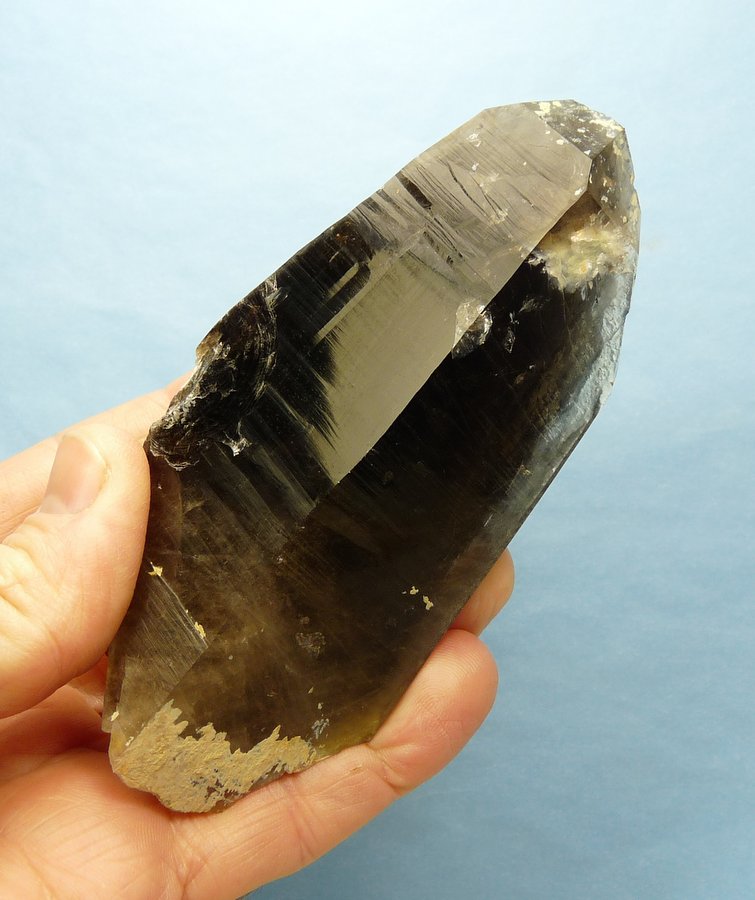
|
| Mineral: | Smoky quartz |
| Locality: | | Cape Lime Company's Dolomite Quarry, Vredendal, West Coast District, Western Cape Province, South Africa |  |
|
| Dimensions: | 98 x 43 x 42 mm |
| Description: |
| Any small cavity with clay is nearly impossible to clean. |
|
| Viewed: |
45425 Time(s) |
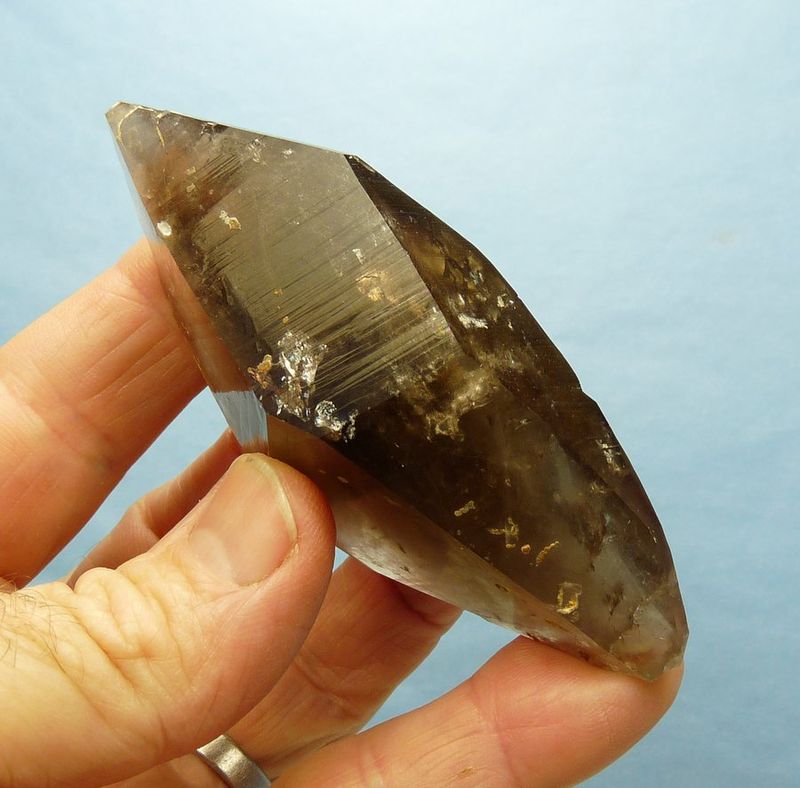
|
_________________
Pierre Joubert
'The tree of silence bears the fruit of peace. ' |
|
| Back to top |
|
 |
Pierre Joubert
Joined: 09 Mar 2012
Posts: 1605
Location: Western Cape



|
 Posted: Sep 26, 2016 13:27 Post subject: Re: Removing stubborn minerals from quartz Posted: Sep 26, 2016 13:27 Post subject: Re: Removing stubborn minerals from quartz |
|
|
I read this interesting article on 'speeding up' the effectiveness of oxalic acid, especially with removing goethite from quartz. It mentions 3 factors; temperature, pH level and concentration of oxalic acid.
https://www.sciencedirect.com/science/article/pii/S0304386X07000618
(link normalized by FMF)
I understand well the concentration and temperature factors. Now I will have to experiment with the pH level. Has anyone tried adding ammonia and can share their experiences? Oxalic acid has a pH of 1.3.
Abstract
Iron oxide is the main contaminant of clay and silicate minerals used during the production of high quality ceramics. Its content has to be removed to generally less than 0.1% for achieving the required whiteness of 90% ISO or higher for clay and silicate materials. Oxalate has been used to dissolve iron oxide from various sources. The dissolution is affected by oxalate concentration, solution pH and temperature. The mineral phase is also critical in determining the reaction rate. Hematite is slow to dissolve whereas iron hydroxide and hydroxyoxides such as goethite and lepidocrosite can be easily dissolved. As the dissolution requires a pH controlled in the region 2.5–3.0 for maximum reaction rate, it is essential to create a hydroxide-oxalate mixture for use in the leaching process. The characteristics of NaOH-, KOH- and NH4OH-oxalic acid mixtures were also determined in this study. Due to the precipitation of salts such as Na2C2O4(s) and NaHC2O4(s) the NaOH-oxalic acid could act as pH buffer for the leaching. Such precipitation also reduces the concentration of the free bioxalate, HC2O4− required for the dissolution of iron oxide. KOH behaves the same as NaOH whereas NH4OH precipitates the less stable salt NH4HC2O4(s) which easily re-dissolves forming soluble oxalate species. Ammonium hydroxide is therefore the most suitable reagent that can be used for pH control during the leaching of iron oxide using oxalate. Using STABCAL, several Eh–pH and stability diagrams were developed to explain the dissolution process.
| Mineral: | Quartz |
| Locality: | | Ceres, Warmbokkeveld Valley, Ceres, Valle Warmbokkeveld, Witzenberg, Cape Winelands, Western Cape Province, South Africa |  |
|
| Dimensions: | Fingers for size |
| Description: |
|
| Viewed: |
40297 Time(s) |
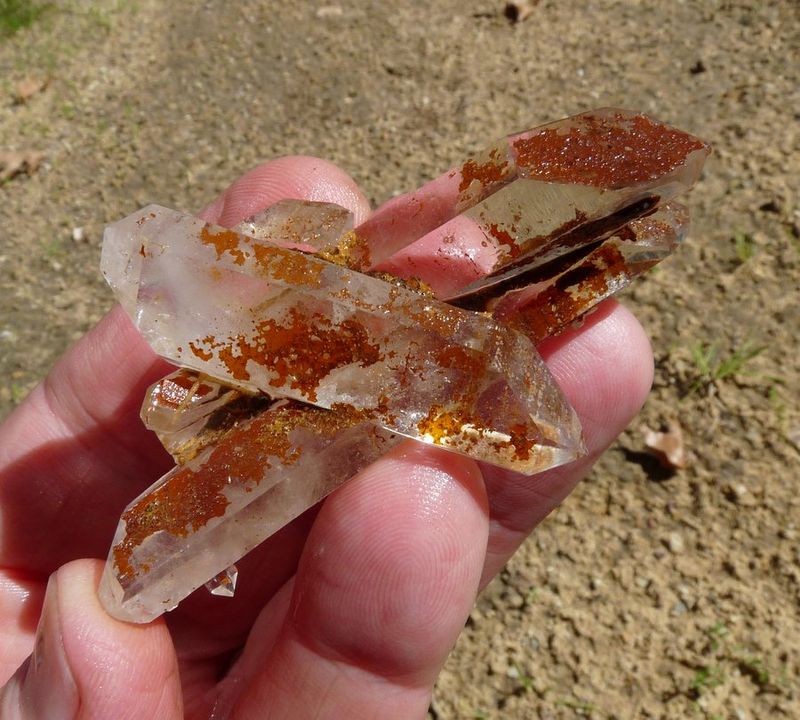
|
_________________
Pierre Joubert
'The tree of silence bears the fruit of peace. ' |
|
| Back to top |
|
 |
GneissWare

Joined: 07 Mar 2008
Posts: 1287
Location: California



|
 Posted: Sep 26, 2016 14:14 Post subject: Re: Removing stubborn minerals from quartz Posted: Sep 26, 2016 14:14 Post subject: Re: Removing stubborn minerals from quartz |
|
|
I clean a lot of rocks. I haven't used oxalic acid in years. In the USA we have a powder called Super Iron Out (SIO), which essentially created a Waller's solution that is very effective at removing iron coatings. It is less toxic and has a pH of about 6.5 so it effective on many things. You can google either SIO or Waller's solution for the chemistry.
For some of the samples depicted, a fabric-cleaning water gun might be pretty effective also.
|
|
| Back to top |
|
 |
|





